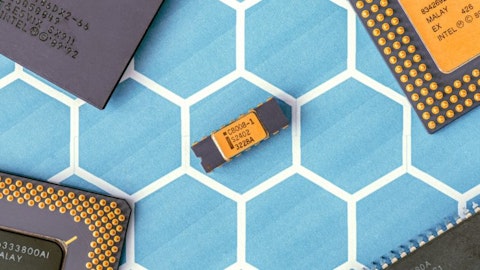ChipMOS TECHNOLOGIES INC. (NASDAQ:IMOS) Q2 2023 Earnings Call Transcript August 4, 2023
Operator: Greetings, and welcome to the ChipMOS Second Quarter 2023 Results Conference Call. At this time, all participants are in a listen-only mode. A question-and-answer session will follow the formal presentation. I would now like to turn the conference over to Dr. GS Shen, of ChipMOS Technologies Strategy and Investor Relations team to introduce the management team of the company in conference. Dr. Shen, you may begin.
G.S. Shen: Thank you, Operator. Welcome everyone to ChipMOS’ second quarter 2023 results conference call. Joining us today from the company are Mr. S.J. Cheng, Chairman and President; and Ms. Silvia Su, Vice President of Finance and Accounting Management Center. We are also joined on the call today by Mr. Jesse Huang, Spokesperson and Senior Vice President of Strategy and Investor Relations. S.J. will chair the meeting and review business highlights and provide color on the operating environment. After Silvia’s review of the company’s key financial results, SJ will provide our current business outlook. All company executives will then participate in an open Q&A session. Please note, we have posted a presentation on the MOPS and also on the ChipMOS’ website www.chipmos.com to accompany today’s conference call.
Before we begin the prepared comments, we advise you to review our forward-looking statements disclaimer, which is noted as the “Safe Harbor Notice” on the second page of today’s presentation. As a reminder, today’s conference call is being recorded and a replay will be made available later today on the Company’s website. At this time, I’d like to now turn the call over to our company’s Chairman and President, Mr. S.J. Cheng. Please go ahead, sir.
S.J. Cheng: Yes, thank you, GS. We appreciate everyone joining our call today. We are pleased with our strong revenue growth results in Q2 led by improvements in our memory and LCD drivers. In terms of Q2 highlights, our Q2 revenue increased 18.2% from Q1 2023; Q2 Gross Margin came in at 17.3%, up 490 basis points compared to Q1 2023; net earnings was NT$0.86 in Q2 2023 , an increase of NT$0.58 compared to NT$0.28 of Q1 2023;accumulated first half of 2023 EPS is NT$1.14. I am pleased to report that our overall utilization rate increased to 60% in Q2 2023 from 52% in Q1 2023. Assembly utilization was at 40% and Testing average was 59%. DDIC significantly increased to 72% and Bumping UT level increased to 60%. This reflects the rebound we are seeing from customers in several of our core markets.
Regarding our manufacturing business, our assembly represented 20.3% of Q2 revenue. Mixed-signal and memory testing represented around 20.2% and wafer bumping represented around 21.7% of Q2 revenue. On a product basis, our DDIC product increased to around 38%, with gold bumping representing about 20.8%. Revenue from DRAM and SRAM represented about 14.7% of Q2 revenue. Our mixed-signal products represented about 7.8%. As additional color on our business, our memory products represented about 33.3% of total Q2 revenue. Memory product revenue was up about 8.2% compared to Q1 2023, but down about 34.2% on a year- over-year basis. DRAM revenue represented about 14.1% of total Q2 revenue. Flash revenue represented about 18.6% of Q2 revenue, and this was slightly up 2.5% compared to Q1.

Photo by Jonas Svidras Unsplash
NOR flash was up around 7% compared to Q1 and NAND Flash represented about 29.4% of Q2 total flash revenue. Moving onto Driver IC and gold bump revenue, it represented about 58.9% of total Q2 2023 revenue and increased significantly 31.6% compared to Q1 2023. In line with broader trends this was slightly down around 4% on a year-over-year basis. Gold bump benefited from a product demand rebound in specific areas and customer restocking. This results in the need to immediately load new wafers coming in for the gold bumping process. This led our gold bump revenue to increase more than 30% compared to Q1 2023. DDIC revenue was also up strong increasing about 28.7% compared to Q1 2023. I am pleased to report that more than 20% of DDIC revenue came from automotive panels in Q2, which was up 14% compared to Q1 2023 and Q2 2022.
This remains a long-term growth market for us. Both TDDI and OLED were up significantly compared to Q1 2023. TDDI represented around 23.5% of Q2 DDIC revenue, and OLED about 14% of Q2 DDIC revenue. Driven by automotive, TDDI and OLED, this helped drive a 27% increase in COG for small panels. On an end-market basis, total revenue from Automotive and Industrial represented about 20.7% of Q2 revenue and increased about 5% over Q1. Consumer represented 21.4% of Q2 revenue. Regarding Smartphones, TVs and Computing as an end market, they accounted about 33.7%, 19.2% and 5%, respectively. All three categories increased more than 30% compared to Q1 2023. Now let me turn the call to Ms. Silvia Su, to review the second quarter 2023 financial results.
Silvia, please go ahead.
Silvia Su: Thank you S.J. All dollar amounts cited in our presentation are in NT dollars. The following numbers are based on the exchange rates of NT$31.14 against US$1 as of June 30, 2023. All the figures were prepared in accordance with Taiwan-International Financial Reporting Standards. Referencing presentation Page 12 Consolidated Operating Results Summary. For the second quarter of 2023, total revenue was NT$5,444 million. Net profit attributable to the company was NT$629 million in Q2. Net earnings for the second quarter of 2023 were NT$0.86 per basic common share or US$0.56 per basic ADS. EBITDA for Q2 was NT$1,731 million. EBITDA was calculated by adding depreciation and amortization together with operating profit. Return on equity of Q2 was 10.3%.
Referencing presentation Page 13, Consolidated Statements of Comprehensive Income. Compared to 1Q23 total 2Q23 revenue increased 18.2% compared to 1Q23. 2Q23 Gross profit was NT$941 million, with gross margin at 17.3% compared to 12.4% in 1Q23. This represents an increase of 4.9ppts. Our operating expenses in 2Q23 were NT$442 million, or 8.1% of total revenue, which is about 10.3% higher compared to 1Q23. Operating profit for 2Q23 was NT$521 million, with operating profit margin at 9.6%, which is about a 5.6ppts increase compared to 1Q23. Net non-operating income in 2Q23 was NT$ 222 million, an increase of NT$ 179 million compared to 1Q23. The difference is mainly due to positive foreign exchange impact of NT$194 million from a foreign exchange loss of NT$44 million in 1Q23 to a foreign exchange gain of NT$150 million in 2Q23.
This was partially offset by a decrease of gain on valuation of financial assets at fair value through profit or loss of NT$21 million. Profit attributable to the company in 2Q23 increased 210.5% compared to 1Q23. This primarily reflects an increase of operating profit of NT$336 million and net non-operating income of NT$179 million and partially offset by the increase of income tax expense of NT$89 million. Basic weighted average outstanding shares were 727 million shares. Compared to 2Q22, total revenue for 2Q23 decreased 20.5% compared to 2Q22. Gross margin at 17.3% decreased 8.1ppts compared to 2Q22. Operating expenses decreased 8.9% compared to 2Q22. Operating profit margin at 9.6% decreased 9.0ppts compared to 2Q22. Net non-operating income decreased NT$87 million compared to 2Q22.
The difference is mainly due to a decrease of share of profit of associates accounted for using equity method of NT$94 million and a lower foreign exchange gain of NT$75 million. This was partially offset by the decrease of net interest expense of NT$16 million and the positive valuation of financial assets at fair value through profit or loss impact of NT$56 million which included the gain of NT$4 million in 2Q23 and loss of NT$52 million in 2Q22. Profit decreased 52.4% compared to 2Q22. The difference is mainly due to a decrease of operating profit of NT$755 million and the net non-operating income of NT$87 million and partially offset by the decrease of income tax expense of NT$150 million. Referencing presentation Page 14 Consolidated Statements of Financial Position & Key Indices.
Total assets at the end of 2Q23 were NT$45,836 million. Total liabilities at the end of 2Q23 were NT$22,010 million. Total equity at the end of 2Q23 was NT$23,826 million. Accounts receivable turnover days in 2Q23 were 76 days. Inventory turnover days was 58 days in 2Q23. Referencing presentation Page 15 Consolidated Statements of Cash Flows. As of June 30, 2023, our balance of cash and cash equivalents was NT$12,293 million, which represents an increase of NT$2,397 million compared to the beginning of the year. Net free cash inflow for the first half of 2023 was NT$1,950 million compared to NT$2,321 million for the same period in 2022. The difference is mainly due to the decrease of operating profit of NT$1,802 million and partially offset by the decrease of CapEx of NT$1,020 million and income tax expense of NT$360 million.
Free cash flow was calculated by adding depreciation, amortization, interest income together with operating profit and then subtracting CapEx, interest expense, income tax expense and dividend from the sum. Referencing presentation Page 16, Capital Expenditures and Depreciation. We invested NT$692 million in CapEx in Q2. The breakdown of CapEx in Q2 was 3.7% for bumping, 57.6% for LCD Driver, 21.2% for assembly and 17.5% for testing. Depreciation expenses were NT$ 1,210 million in Q2. As of July 31, 2023, the Company’s outstanding ADS number was approximately 4.3 million units, which represents around 12% of the Company’s outstanding common shares. That concludes the financial review. I will now turn the call back to our Chairman Mr. S.J. Cheng for our outlook.
Please go ahead, sir.
S.J. Cheng: Thank you, Silvia. According to the current industry situation and customers’ feedback, and given the stronger Q2 results, we expect operating momentum will see a gradual rebound in the near term with the second half of 2023 better than the first half of 2023. In our DDIC product, automotive panel and OLED demand is stable and gradually rebounding, with the inventory situation cleaning up a bit. This results in the need to immediately load new wafers coming in for the gold bumping and further assembly/testing processes. This leads to the UT level of high-end DDIC test platforms further improving and some specific high-end test platform is near fully occupied. In our memory product, we expect DRAM demand will start to improve in the middle of Q3 as we benefit from memory IDMs lowering their UT level.
Coupled with the NAND Flash demand is rebounding. Combined we expect an overall rebounding in memory’s business. We think memory product momentum will be better than DDIC in second half of 2023, even with continued destocking at certain customers. Regarding our 2023 CapEx budget, our strategy remains in place. We plan to carefully invest in green energy, AI and automation. To maintain our competitive advantage and strength, we will add capacity depending on the UT level and customers’ further demand. For example, we deferred DDIC high-end testers, which were already pulled into the first half. We also continue to implement cost reduction and quality improvement actions where possible to gain leverage in our business. Lastly, we continue to closely corporate with vendors to gain insight into the channel.
Our focus remains on expanding our leadership position and building value for shareholders. This includes returning capital to shareholders with our latest dividend distribution on July 20. Operator that concludes our formal remarks. We can now take questions.
See also Top 20 Electronic Gadgets for a Smart Home and 15 Most Walkable Cities in the US.
Q&A Session
Follow Chipmos Technologies Inc (NASDAQ:IMOS)
Follow Chipmos Technologies Inc (NASDAQ:IMOS)
Receive real-time insider trading and news alerts
Operator: Thank you. At this time, we will be conducting a question-and-answer session. Our first question comes from Jerry Su from Credit Suisse. You may begin.
Jerry Su: Thanks for taking my question. Firstly, would you please give us more color about the QoQ revenue and gross margin for each of memory and DDIC? Secondly, can you comment about the local DDIC competitor’s recent price cut in recent? Further, how is your comment about the growing competition from DDIC backend player in China? Lastly, please share your picture for mid to long-term business momentum and direction after this year inventory correction.
S.J. Cheng: According to the current industry situation and customers’ feedback, we expect Q1 will be the bottom for the year, with operating momentum continuing to gradually rebound in Q3 and Q4. We expect the second half will be better than the first half, with 8%, 10% growth, as we move through 2023. In memory, we think memory product momentum will be better than DDIC in the second half of 2023 since DDIC has performed at a significantly better QoQ growth rate in Q2. We expect DRAM demand will be more clear in mid or late Q3, coupled with the NAND Flash demand rebounding. In DDIC, we have already pulled in the deferred DDIC high-end testers in the first half. Therefore, DDIC revenue in H2 will benefit from the new capacity.
As for gross margin, we expect it could improve by UT level moving up and a better product mix. Regarding to the price issue, we would still maintain the price level of high-end testers due to a higher UT rate for OLED product. For low-end testers and COF, we are taking this on a customer-by-customer basis and retaining some flexibility in the OEM price to the further improvement of the utilization rate. We see the hurdle from limited 28 nanometers DDIC wafer supply in China. In the meantime, we will continue to improve our quality competitiveness and expand the penetration rate of high-end products such as OLED, automotive panels, and high-end TVs to maintain the company’s competitive advantage. For mid to long-term, in terms of memory, we are optimistic about the product trend of upgrading commodity DRAM to DDR5 and high-density, multi-chip stacked NAND Flash.
For DDIC, apart from the increase in the penetration rate of mobile phones, as the use of OLED panels in other applications increases, such as laptops, tablets and automotive, et cetera, it is also another driving force for our DDIC to continue to grow in the future. In addition, our logic mixed-signal products, such as PMIC, sensor and panel peripheral chips, will expand from general consumer products, such as mobile phones to other fields such as automotive. Of course, we still benefit from the continuous increase in the proportion of revenue in automotive applications, which covers our three major product segments, DDIC, memory and logic mixed-signal.
Operator: Next question comes from Anthony Liu from Yuanta. You may begin.
Anthony Liu: From the presentation, we see memory the segment grew 8% QoQ, while assembly UT rate was still weak. Does it imply revenue growth is mainly from memory testing?
S.J. Cheng: In memory wafer test and final test, we benefited from rush orders for consumer niche DRAM in Q2. However, our assembly business still suffered from slow demand of commodity DRAM.
Anthony Liu: Please give us more color about DRAM, NAND and NOR business momentum in the second half.
S.J. Cheng: By ranking, we think NAND Flash can grow more than DRAM, followed by flatter NOR Flash.
Anthony Liu: DDIC and gold bump UT rate significantly increased in Q2. Would it maintain the sequential QoQ growth in the second half?





